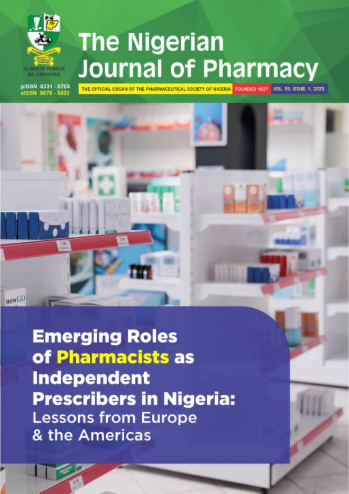Evaluation of Pharmacist Interventions on Treatment Outcomes of Pulmonary Tuberculosis Patients in Secondary Health Facilities Abuja
DOI:
https://doi.org/10.51412/psnnjp.2025.03Keywords:
Pharmacist, Tuberculosis, Adherence, InterventionAbstract
Introduction: Tuberculosis is a chronic infection that remains one of the major health problems in most developing countries. Poor treatment outcomes have serious consequences which include spread of the disease, morbidity and mortality. The world health organization (WHO) recommended minimum successful outcomes of 85%; this has not been achieved in most facilities rendering the
services. The aim of the study was to evaluate the impact of Pharmacist interventions on the treatment outcomes of pulmonary tuberculosis patients in secondary health facilities in Abuja.
Method: A total of 110 patients undergoing Directly Observed Therapy Short course (DOTS) were recruited and split into control and intervention groups. Both groups received health education on; healthy living, cough etiquette, disease pathophysiology, infection control, prevention, and medication adherence. But the intervention group received phone calls and text messages throughout
their six-month treatment. A questionnaire was administered to both groups before the health education as in the case with the intervention group, this was to assess their baseline knowledge of the disease and to measure the medication adherence level, while the post-intervention survey evaluated the impact of pharmacist-led interventions on improving knowledge, adherence, and treatment
outcomes on both groups. The questionnaire included a combination of multiple-choice questions, Likert-scale items, and open-ended questions to obtain comprehensive insights into the respondents' perspectives. In addition to the questionnaire, a specially designed form (proforma), was employed to systematically collect data on treatment outcomes from the respondents' hospital records post-
intervention.
Results: The study showed a statistically significant difference (p<0.05) in medication adherence after interventions with more than 70% of participants having good adherence(100%), disease knowledge and social history in intervention group accompanied with phone calls and text messages as compared to control group with 75.9% non-adherance. The study established successful treatment outcomes of tuberculosis of 87.5% in the intervention group as against 74.1% in the control group from the secondary healthcare facilities used for the research.
Conclusion: The study showed that pharmacist intervention improves knowledge of tuberculosis disease, medication adherence with 87.5% successful treatment outcomes for patients with tuberculosis attending the secondary healthcare facilities in Abuja.
References
World Health Organization (2016a) Global Tuberculosis Report 2016. http://apps.who.int/iris/bitstream/10665/191102/1/9789241565059_ eng.pdf . (Accessed January, 2024)
Babatunde OA, Elegbede OE, Ayodele M, Fadare JO, Isinjaye AO, Ibirongbe DO, Akinyandenu J (2013) Factors affecting treatment outcomes of tuberculosis in a tertiary health centre in Southwestern Nigeria. International Journal of Social Sciences and Humanity Review, 4(2):209-218.
World Health Organization 2018. Global Tuberculosis Report 2018 http://apps.who.int/iris/bitstream/10665/191102/1/9789241565059_eng.pdf. (Accessed th February 18 2024)
National Tuberculosis and Leprosy Control Program (NTBLCP) Manual 2010. http://www.who.int/hiv/pub/guidelines/nigeria_tb.pdf (Accessed February 20 2024)
Malaysia Health Technology Assessment Section. Management of TB (3rd ed.) 2012. http://www.moh.gov.my th. Accessed February 6 2024
Abrogoua DP, Kamenan BA, Ahui BJ, Doffou E. (2016) Pharmaceutical interventions in the management of tuberculosis in a pneumophtisiology department, Ivory Coast. Therapeutic Clinical Risk Management, 22(12):1749-1756.
Gillespie U, Alassaad A, Henrohn D, Garmo H, Hammarlund-Udenaes M, Toss H, Kettis-Lindblad A, Melhus H, Mörlin C.(2009) A
comprehensive Pharmacist intervention to reduce morbidity in patients 80 years or older: a randomized controlled trial. Archives International Medicine, 169(9):894-900.
Schnipper JL, Kirwin JL, Cotugno MC, Wahlstrom SA, Brown BA, Tarvin E, Kachalia A, Bates DW.(2006). Role of pharmacist counseling in preventing adverse drug events after hospitalization. Archives International Medicine, 166(5):565-571.
Kausch C, Tan SP, Boelle P, Tilleul P.(2005) Economic consequences and acceptance of a clinical pharmacist in a surgery ward. Journal of
Clinical Pharmacy, 24(2):90-97.
Lukoye D, Ssengooba W, Musisi, K, Kasule GW, Cobelens F.J, Joloba M. Gomez GB (2015) Variation and risk factors of drug resistant
tuberculosis in sub-Saharan Africa: A systematic review and meta-analysis. BMC Public Health. 15:291.http://doi.org/10.1186/s12889-015-
-8
Dudala SR, Rajshwar RA, RaviKumar BP (2015) In factors influencing treatment outcome of new smear positive tuberculosis patients in tuberculosis unit Khammam. International Journal of Medical and Health Sciences, 2;2:195-204
Yamane T (1967)Statistics: An Introductory Analysis. Herper and Row. 60(310):886.
Mellor JE, Curran K, Pisanic N (2011) Evaluating the efficacy of adherence strategies in tuberculosis care: A systematic review. International Journal of Tuberculosis and Lung Diseases, 15(6):762–770.
Cooper H, Booth K, Fear S, Gill G (2001) Chronic Disease Patient Education: Lessons from Meta- analysis. Patient Education and Counseling. 44(2):107-117
World Health Organization 2003. WHO Adherence to long term therapies. http://Apps.who.int/medicinedocs/en/d/Js4883e/th 8.9.1.html. Accessed March 5 2024
Ojieabu WA, Erah PO (2011) Pharmacist intervention to improve outcome of tuberculosis treatment in a tertiary health facility in South western Nigeria. Journal of Pharmaceutical and Allied Sciences 8(2). Retrieved from African Journal Online
Joseph MR, Porath S, Eapen CK. (2000) Integrating private health care in the national tuberculosis program. Experience from Ernakulam - Kerala. Indian Journal of Tuberculosis, 17-19.
Aamir S, Latif N, Basit A (2016) Role of counselling to facilitate compliance to the DOTS for the treatment of tuberculosis. Archives of
Pulmonology and Respiratory Care, 2(1):028-031.
Venkatapraveen A, Rampure MV, Patil N, Hinchageri SS, Lakshmi DP (2012) Assessment of clinical pharmacist intervention to improve
compliance and health care outcomes of tuberculosis patients. Der Pharmacia Lettre. 4(3):931-937.
Downloads
Views | PDF Downloads:
531
/ 183
Published
How to Cite
Issue
Section
License
Copyright (c) 2025 The Nigerian Journal of Pharmacy

This work is licensed under a Creative Commons Attribution-NonCommercial 4.0 International License.



